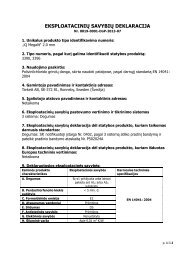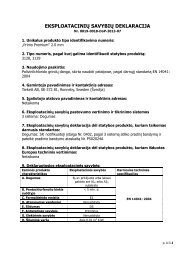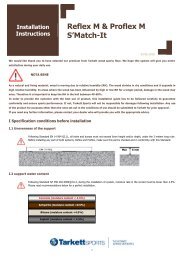Linoleum xf - Tarkett Profesionalams
Linoleum xf - Tarkett Profesionalams
Linoleum xf - Tarkett Profesionalams
You also want an ePaper? Increase the reach of your titles
YUMPU automatically turns print PDFs into web optimized ePapers that Google loves.
<strong>Linoleum</strong> <strong>xf</strong><br />
– cleaning and maintenance<br />
The greatest advance for<br />
<strong>Linoleum</strong> <strong>xf</strong> is the reduced<br />
cleaning and maintenance.<br />
Compared with untreated<br />
linoleum flooring, several<br />
steps are no longer necessary,<br />
and the whole cleaning<br />
and maintenance process<br />
is simplified. Always<br />
follow <strong>Tarkett</strong>’s cleaning<br />
and maintenance system to<br />
be sure to get the very best<br />
result.<br />
Cleaning in three<br />
easy steps<br />
Our unique surface protection<br />
makes it possible to<br />
reduce cleaning and<br />
maintenance to three easy<br />
steps, yet still gets top<br />
flooring performance in<br />
every way.<br />
General advice<br />
• Resilient floors are<br />
damaged by solvents.<br />
• Wipe up any grease and<br />
spilt oil immediately, as<br />
it may damage the<br />
surface.<br />
• Black rubber wheels and<br />
rubber feet can discolour<br />
the floorcovering.<br />
• To avoid damage, chairs<br />
and stools should be<br />
fitted with quality plastic<br />
protective end caps.<br />
• Remember, the light<br />
colours need more<br />
frequent cleaning.<br />
1. Preventive care for a cleaner environment<br />
Entrance matting<br />
About 80% of surface soiling that has to be cleaned off is brought from outside. And 90%<br />
of that soiling can be avoided by an effective and correctly dimensioned entrance mat.<br />
2. Daily and regular cleaning<br />
Dry mopping / Sweeping<br />
Removes dust and dirt. Use yarn or microfibre mops, or disposable mops, dry or impregnated.<br />
Use a suitable broom with soft bristles.<br />
Vacuum cleaning (for large areas)<br />
Removes dust and loose dirt. Can supplement mopping in confined spaces. Recommended for<br />
large areas and initial site cleaning.<br />
Damp mopping<br />
Use a mop dampened with water or detergent solution. It is essential that water does not<br />
stay on the floor or leave a film. The floor should be virtually dry after 15–20 seconds.<br />
Wet mopping<br />
The floor is mopped using a wrung-out yarn mop head. The mop should not be over wet<br />
(to avoid wiping up afterwards). In some cases, it may be necessary to occasionally rinse<br />
with clean water. For very heavily soiled areas only.<br />
Combined machine (for large areas)<br />
Industrial machine-cleaning (large areas). Use diluted neutral detergent. Adjustable speed (low<br />
150–250 rpm to higher). Beige/red pads are usually most suitable, but check with pad guide.<br />
Spot and stain removal<br />
Treat stains immediately. Handle spot using a white/red nylon pad with methylated spirit,<br />
cleaning spirit or neutral detergent (solvents should not be used). Work from the outside of<br />
the mark towards its centre. Rinse and wipe afterwards with clean water.<br />
3. Periodic cleaning<br />
+<br />
or<br />
or<br />
or<br />
Spray cleaning (Spot-cleaning and buffing in one operation) + Dry buffing<br />
For light soiling and traffic wear to revitalize the surface. Mix water and neutral detergent<br />
or floor maintainer in the container tank. Suitable speed 300–500 / 1000 rpm.<br />
Dry buffing is then used to recover gloss when required. White pad is recommended.<br />
Suitable speed is 300-1000 rpm.<br />
+ +<br />
or<br />
Machine scrubbing + Wet vacuuming + Dry buffing<br />
Thorough machine-cleaning using a suitable pad. Use diluted neutral detergent.<br />
Low speed 150-250 rpm. Red pads are usually most suitable. After scrubbing cross-wise, wet<br />
vacuum to collect slurry, rinse with clear water and wet vacuum once again. Always dry-buff<br />
to restore finish (Used to restore the trafficked surface. Red pad is recommended. Suitable<br />
speed is 500-1000 rpm depending on the flooring material).<br />
4







